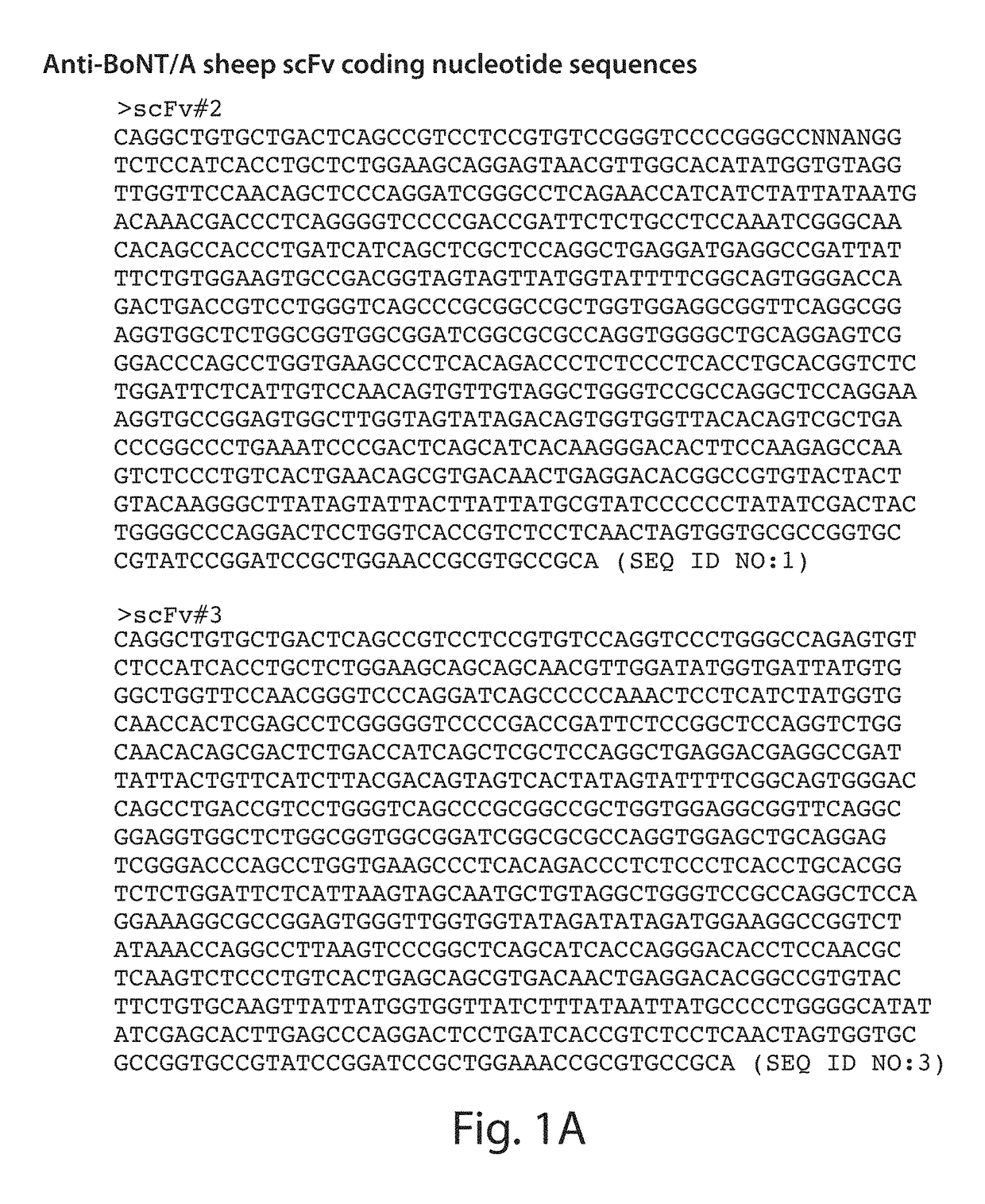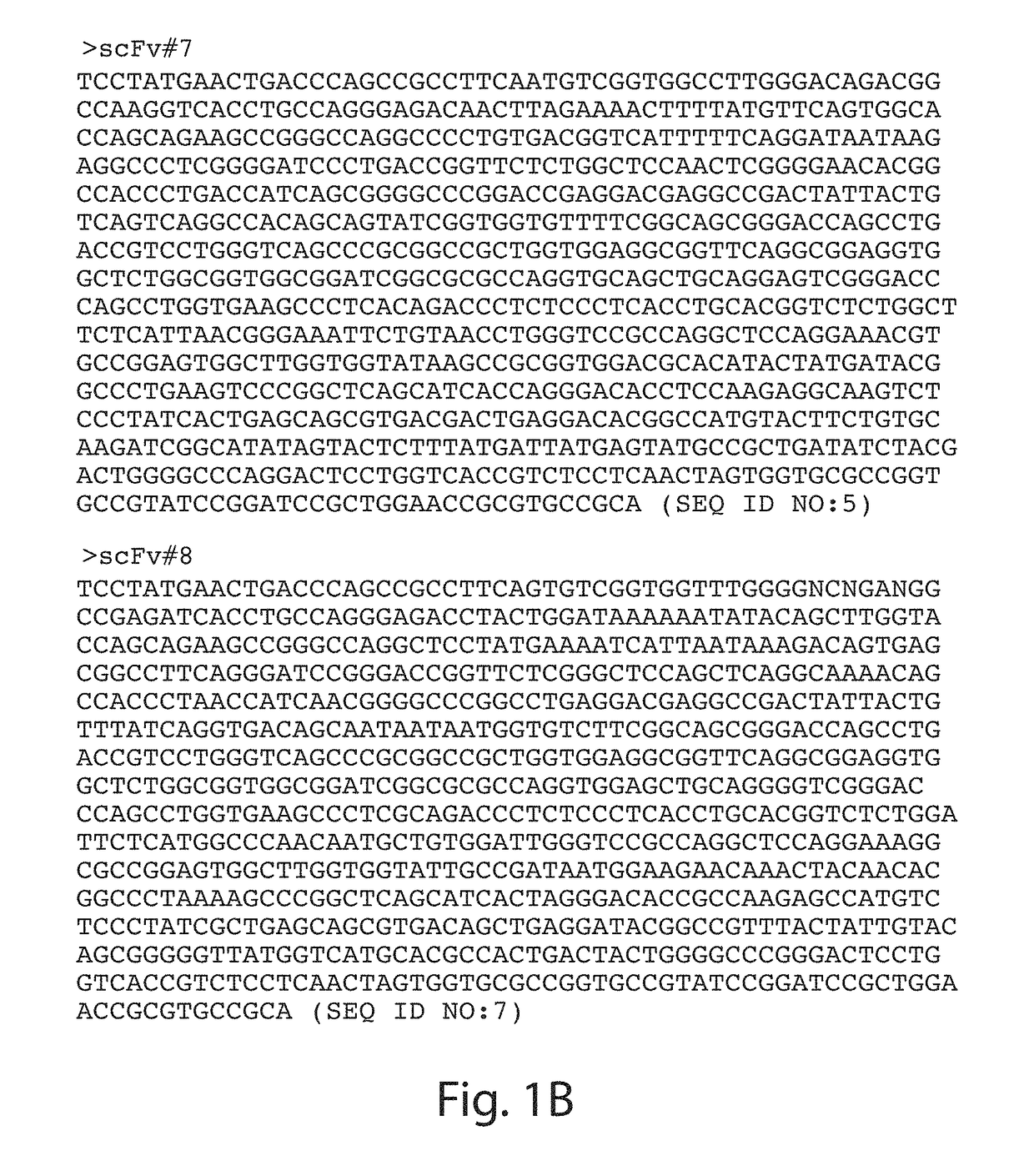Methods, compositions and kits for treating a subject using a recombinant heteromultimeric neutralizing binding protein
a technology of neutralizing binding protein and recombinant heteromultimeric, which is applied in the direction of antibacterial agents, peptide/protein ingredients, antibody medical ingredients, etc., can solve the problems of multiple antibodies that can bind to different targets, the development of single antibody therapeutic agent often requires years of clinical study, and the cost and long time-consuming of antibody production and storag
- Summary
- Abstract
- Description
- Claims
- Application Information
AI Technical Summary
Benefits of technology
Problems solved by technology
Method used
Image
Examples
example 1
Toxins and Reagents
[0243]Botulinum neurotoxin serotype A1 (BoNT / A) and serotype B (BoNT / B) were obtained from Metabiologics Inc. Each batch of toxin was calibrated to establish the LD50 dose in mice and stored in aliquots at −80° C. until use. Purified recombinant BoNT serotype A1 and B holotoxins containing mutations rendering them catalytically inactive (ciBoNTA, ciBoNTB) obtained. Sheep anti-BoNT / A1 antiserum was produced by immunization of sheep with BoNT / A1 toxoid followed by BoNT / A1 holotoxin. Less than 1 μl of this sheep antitoxin serum protects mice from lethality when co-administered with 10,000-fold the LD50 of BoNT / A1. Reagents for Western blotting were purchased from KPL (Gaithersburg, Md.).
[0244]C. difficile holotoxins TcdA and TcdB were generated by transformation of shuttle vectors pHis1522 (pHis-TcdA and pHis-TcdB respectively) into B. megaterium described in Yang et al. 2008 BMC Microbiolgoy 8:192. Point mutations were introduced into conserved amino acids that are ...
example 2
Alpaca Immunization and VHH-Display Library Preparation
[0247]Purified, catalytically inactive mutant forms of full-length recombinant BoNT / A (ciBoNTA) and BoNT / B (ciBoNTB) proteins were obtained as described in Webb et al. 2009 Vaccine 27: 4490-4497. Alpacas (two animals per immunization type) were immunized with either ciBoNTA or with ciBoNTB. Additional alpacas were immunized with aTcdA or aTcdB. The immunization regimen employed 100 μg of protein in the primary immunization and 50 μg in three subsequent boosting immunizations at three weekly intervals in aluminum hydroxide gel adjuvant in combination with oligodeoxynucleotides containing unmethylated CpG dinucleotides (alum / CpG; Superfos Biosector; Copenhagen, Denmark) adjuvant. Five days following the final boost immunization, blood from each animal was obtained for lymphocyte preparation and VHH-display phage libraries were prepared from the immunized alpacas as previously described (Maass et al. 2007 Int J Parasitol 37: 953-96...
example 3
Anti-BoNT VHH Identification and Preparation
[0248]The VHH-display phage libraries were panned for binding to ciBoNTA or ciBoNTB targets that were coated onto each well of a 12-well plate. Coating was performed by overnight incubation at 4° C. with one ml of a 5 μg / ml target solution in PBS, followed by washing with PBS and two hours incubation at 37° C. with blocking agent (4% non-fat dried milk powder in PBS). Panning, phage recovery and clone fingerprinting were performed as previously described (Ibid.). Based on phage ELISA signals, a total of 192 VHH clones were identified as strong candidate clones for binding to BoNT / A, and 142 VHH clones were identified as strong positives for binding to BoNT / B respectively. Of the strong positives, 62 unique DNA fingerprints were identified among the VHHs selected for binding to BoNT / A and 32 unique DNA fingerprints were identified for VHHs selected for binding to BoNT / B. DNA sequences of the VHH coding regions were obtained for each phage c...
PUM
| Property | Measurement | Unit |
|---|---|---|
| concentration | aaaaa | aaaaa |
| concentration | aaaaa | aaaaa |
| concentration | aaaaa | aaaaa |
Abstract
Description
Claims
Application Information
 Login to View More
Login to View More - R&D
- Intellectual Property
- Life Sciences
- Materials
- Tech Scout
- Unparalleled Data Quality
- Higher Quality Content
- 60% Fewer Hallucinations
Browse by: Latest US Patents, China's latest patents, Technical Efficacy Thesaurus, Application Domain, Technology Topic, Popular Technical Reports.
© 2025 PatSnap. All rights reserved.Legal|Privacy policy|Modern Slavery Act Transparency Statement|Sitemap|About US| Contact US: help@patsnap.com



